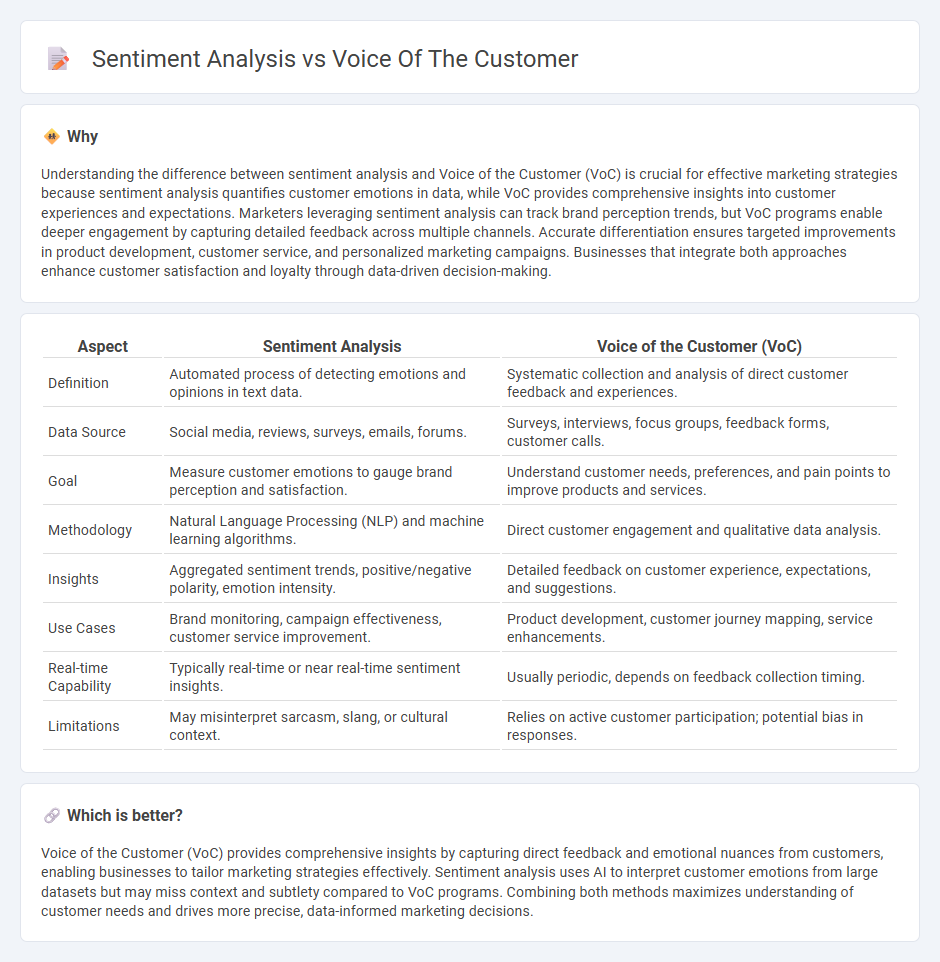
Sentiment analysis evaluates customer emotions and opinions from text data, revealing trends in brand perception through algorithms that classify positive, negative, or neutral sentiments. Voice of the Customer (VoC) collects direct feedback from customers via surveys, interviews, and reviews to understand needs and improve experiences comprehensively. Explore the key differences and benefits of sentiment analysis and VoC to enhance your marketing strategy.
Why it is important
Understanding the difference between sentiment analysis and Voice of the Customer (VoC) is crucial for effective marketing strategies because sentiment analysis quantifies customer emotions in data, while VoC provides comprehensive insights into customer experiences and expectations. Marketers leveraging sentiment analysis can track brand perception trends, but VoC programs enable deeper engagement by capturing detailed feedback across multiple channels. Accurate differentiation ensures targeted improvements in product development, customer service, and personalized marketing campaigns. Businesses that integrate both approaches enhance customer satisfaction and loyalty through data-driven decision-making.
Comparison Table
| Aspect | Sentiment Analysis | Voice of the Customer (VoC) |
|---|---|---|
| Definition | Automated process of detecting emotions and opinions in text data. | Systematic collection and analysis of direct customer feedback and experiences. |
| Data Source | Social media, reviews, surveys, emails, forums. | Surveys, interviews, focus groups, feedback forms, customer calls. |
| Goal | Measure customer emotions to gauge brand perception and satisfaction. | Understand customer needs, preferences, and pain points to improve products and services. |
| Methodology | Natural Language Processing (NLP) and machine learning algorithms. | Direct customer engagement and qualitative data analysis. |
| Insights | Aggregated sentiment trends, positive/negative polarity, emotion intensity. | Detailed feedback on customer experience, expectations, and suggestions. |
| Use Cases | Brand monitoring, campaign effectiveness, customer service improvement. | Product development, customer journey mapping, service enhancements. |
| Real-time Capability | Typically real-time or near real-time sentiment insights. | Usually periodic, depends on feedback collection timing. |
| Limitations | May misinterpret sarcasm, slang, or cultural context. | Relies on active customer participation; potential bias in responses. |
Which is better?
Voice of the Customer (VoC) provides comprehensive insights by capturing direct feedback and emotional nuances from customers, enabling businesses to tailor marketing strategies effectively. Sentiment analysis uses AI to interpret customer emotions from large datasets but may miss context and subtlety compared to VoC programs. Combining both methods maximizes understanding of customer needs and drives more precise, data-informed marketing decisions.
Connection
Sentiment analysis leverages natural language processing to interpret customer emotions within Voice of the Customer (VoC) data, enabling businesses to quantify positive, negative, or neutral customer feedback. Integrating sentiment insights from VoC programs helps marketers identify customer pain points and preferences, driving targeted product improvements and personalized marketing strategies. This connection enhances customer experience management by transforming qualitative feedback into actionable, data-driven marketing decisions.
Key Terms
**Voice of the Customer:**
Voice of the Customer (VoC) captures authentic, detailed feedback from customers through surveys, reviews, and interviews, providing comprehensive insights into customer needs and expectations. Unlike sentiment analysis, which interprets emotions from text data using algorithms, VoC offers direct, qualitative data that drives strategic improvements in products and services. Explore how effective VoC programs can transform your business by learning more about advanced customer feedback techniques.
Feedback Collection
Voice of the Customer (VoC) centers on systematically gathering direct customer feedback through surveys, interviews, and focus groups to understand explicit needs and expectations. Sentiment analysis employs AI-driven tools to interpret emotions and opinions from unstructured data such as social media posts and reviews, providing real-time insights into customer attitudes. Explore more to enhance your feedback collection strategy with these complementary approaches.
Customer Expectations
Voice of the Customer (VoC) captures detailed customer expectations through direct feedback, surveys, and interviews, providing actionable insights for improving products and services. Sentiment analysis evaluates the emotional tone in customer interactions, helping businesses gauge overall satisfaction and identify trends in customer sentiment. Discover more about how these tools shape customer experience strategies and drive business growth.
Source and External Links
What is Voice of the Customer (VoC)? A Complete Guide - Salesforce - Voice of the Customer (VoC) is a practice focused on listening to and interpreting customer needs to improve business decisions and customer satisfaction.
What is Voice of the Customer? A Guide to VOC Strategy - TechTarget - Voice of the customer (VOC) involves collecting and analyzing customer feedback to enhance the customer experience and overall business performance.
What is Voice of the Customer & How it Drives ROI | Sprinklr - Voice of the customer (VoC) is about capturing, processing, and understanding customer feedback to improve customer experience and drive business success.
 dowidth.com
dowidth.com